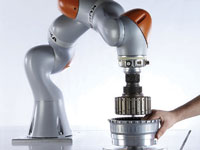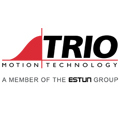
Posted to News on 23rd Apr 2016, 00:00
The breakthrough of smart robots at Automatica 2016
Robots have left their protective cage. They now work closely with people. Automatica (Munich 21-24 June, 2016) will highlight how the automation industry is facing the challenge of this technology.

Clever, lightweight robot arms are faithful helpers in production, especially where the high productivity of a robot can be combined with the sensory and cognitive capabilities of people. They relieve people of monotonous or heavy work and consequently ensure better health and quality of life. “The borders between industrial and service robotics are merging,” asserts Wilfried Eberhardt, chief marketing officer at Kuka AG.
Smart robots belong to the factory of the future in this context. “A technology transfer is taking place, which opens up new application possibilities,” he continues.
Regardless of whether the LBR iiwa from Kuka, YuMi from ABB Robotics or the service robots from PAL Robotics and Rethink Robotics, conventional industrial robot manufacturers as well as service robotics companies and new players in the market provide marketable solutions for the interaction between humans and robots.
Service robotics and Industry 4.0
The fourth industrial revolution has begun with a networked production world that can react flexibly and fully automated to changing needs. Robots, which are mobile and collaborate with people, are indispensable in this. Industry 4.0 and the resulting applications are a chance to establish Europe as a technology leader and pioneer. An important milestone here is human-robot collaboration that ensures workplace ergonomics and better working conditions. Service robotics applications can help to master the challenges of an aging society.
Intelligent service robots have become part of everyday life. They assume complex tasks, which could not be automated previously, with high precision and high quality. They can be programmed and are capable of learning. As a result, they are used in very different projects, which increases productivity. Thanks to stereo vision and 3D sensors, robots can scan their environment and consequently make elaborate security barriers superfluous.
Connected to the environment via sensors and actuators, robots become cyber-physical systems (CPS), which are being networked increasingly with each other and with the Internet. The Internet of Things (IoT) will network all devices and robots of an automated production chain regardless of location in the future.
Lucrative potential for Europe
According to the International Federation of Robotics (IFR), the market for professional service robotics will continue to grow tremendously. About 150,000 units are expected to be sold by 2018, thereby providing sales of approx. 20 billion US dollars. The growth rate in this area was a solid 11.5% last year alone. The most important applications in the civilian sector are agriculture, logistics and medicine. Henrik Schunk, managing director of Schunk, states it succinctly: “Service robotics is in the middle of implementation. It has the potential to drive the Industrial Revolution forward to an incredible degree.”
In addition to robots, Automatica 2016 will also put the spotlight on machine vision. Machine vision (MV) is enjoying sales increases in double digits. Vendors and system integrators in the machine vision industry constantly succeed again and again to provide new automation concepts with pioneering developments. Advances in service robotics, the trend topic Industry 4.0 and human-machine collaboration as well as industry-specific tasks from leading industries sectors are still making new demands on the innovative power of machine vision today.
“The very quick response to user requests distinguishes our industry while ensuring dynamism and growth at the same time,” emphasises Dr Norbert Stein, managing director of Vitronic and CEO of VDMA Robotics + Automation. “The figures also underscore this. While robotics and automation achieved a new record in 2014 with an increase of nine percent, it was once again machine vision that saw the strongest growth with an increase of 16 percent to 1.9 billion euros in sales.”
The positive development has a tangible reason: many automation projects can simply not be realised without vision systems. This begins with simple tasks such as reading bar codes or data matrix codes, continues to standard tasks such as sorting cookies or candy in the food industry and goes all the way to highly complex machine vision tasks in the automotive industry.
Rise the of the smart cameras
Visitors to Automatica can experience on site especially how easy it is to solve standard tasks today. The magic word here is smart camera. It not only takes pictures, but also evaluates them it thanks to an integrated processing unit for processing data. Consequently, a PC is superfluous. The new developments in this sector convince thanks to their compact design with significantly enhanced performance.
Jörg Küchen, vice president of Cognex, explains: “By combining faster frame rates with high computing power, users can optimise resolution, speed and performance even on the fastest production lines. Thanks to that, they can reduce cycle times, increase productivity, increase resolution without loss of throughput or perform additional testing without increasing the cycle time.”
However, not every problem can be solved with standard components and plug+play installations. To the contrary, if there is a certain degree of complexity, system integrators are required such as ISRA Vision, Vitronic and VMT. Harald Mikeska, VMT machine vision specialist from the very beginning, knows what is important in complex applications, especially in the automotive industry: “The great variety of models, in particular in the premium area, requires increased inline-monitoring of assembly processes.
“At a major automotive manufacturer in the Stuttgart area, up to 120 different assembly parts and components are monitored on the underbody directly on the line in continuous operation. In addition, high-performance machine vision and laser scanner solutions from VMT with up to 12 cameras are used, which have to achieve an availability of greater than 99.8 percent.”










